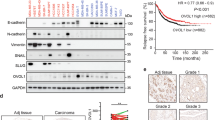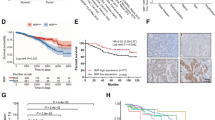Abstract
Transforming growth factor-beta (TGF-β) is a multifunctional cytokine that regulates many biological events including cell motility and angiogenesis. Here, we investigated the role of elevated TGF-β2 level in triple negative breast cancer (TNBC) cells and the inhibitory effect of silibinin on TGF-β2 action in TNBC cells. Breast cancer patients with high TGF-β2 expression have a poor prognosis. The levels of TGF-β2 expression increased significantly in TNBC cells compared with those in non-TNBC cells. In addition, cell motility-related genes such as fibronectin (FN) and matrix metalloproteinase-2 (MMP-2) expression also increased in TNBC cells. Basal FN, MMP-2, and MMP-9 expression levels decreased in response to LY2109761, a dual TGF-β receptor I/II inhibitor, in TNBC cells. TNBC cell migration also decreased in response to LY2109761. Furthermore, we observed that TGF-β2 augmented the FN, MMP-2, and MMP-9 expression levels in a time- and dose-dependent manner. In contrast, TGF-β2-induced FN, MMP-2, and MMP-9 expression levels decreased significantly in response to LY2109761. Interestingly, we found that silibinin decreased TGF-β2 mRNA expression level but not that of TGF-β1 in TNBC cells. Cell migration as well as basal FN and MMP-2 expression levels decreased in response to silibinin. Furthermore, silibinin significantly decreased TGF-β2-induced FN, MMP-2, and MMP-9 expression levels and suppressed the lung metastasis of TNBC cells. Taken together, these results suggest that silibinin suppresses metastatic potential of TNBC cells by inhibiting TGF-β2 expression in TNBC cells. Thus, silibinin may be a promising therapeutic drug to treat TNBC.







Similar content being viewed by others
References
Dent R, Trudeau M, Pritchard KI, Hanna WM, Kahn HK, Sawka CA, et al. Triple-negative breast cancer: clinical features and patterns of recurrence. Clin Cancer Res. 2007;13:4429–34. doi:10.1158/1078-0432.CCR-06-3045.
Lin NU, Claus E, Sohl J, Razzak AR, Arnaout A, Winer EP. Sites of distant recurrence and clinical outcomes in patients with metastatic triple-negative breast cancer: high incidence of central nervous system metastases. Cancer. 2008;113:2638–45. doi:10.1002/cncr.23930.
Khokher S, Qureshi MU, Mahmood S, Nagi AH. Association of immunohistochemically defined molecular subtypes with clinical response to presurgical chemotherapy in patients with advanced breast cancer. Asian Pac J Cancer Prev. 2013;14:3223–8.
Thiery JP, Acloque H, Huang RY, Nieto MA. Epithelial-mesenchymal transitions in development and disease. Cell. 2009;139:871–90. doi:10.1016/j.cell.2009.11.007.
Feng XH, Derynck R. Specificity and versatility in tgf-beta signaling through Smads. Annu Rev Cell Dev Biol. 2005;21:659–93. doi:10.1146/annurev.cellbio.21.022404.142018.
Ikushima H, Miyazono K. TGFbeta signalling: a complex web in cancer progression. Nat Rev Cancer. 2010;10:415–24. doi:10.1038/nrc2853.
Xu J, Lamouille S, Derynck R. TGF-beta-induced epithelial to mesenchymal transition. Cell Res. 2009;19:156–72. doi:10.1038/cr.2009.5.
Giampieri S, Manning C, Hooper S, Jones L, Hill CS, Sahai E. Localized and reversible TGFbeta signalling switches breast cancer cells from cohesive to single cell motility. Nat Cell Biol. 2009;11:1287–96. doi:10.1038/ncb1973.
Kim S, Lee J, Jeon M, Nam SJ, Lee JE. Elevated TGF-beta1 and -beta2 expression accelerates the epithelial to mesenchymal transition in triple-negative breast cancer cells. Cytokine. 2015;75:151–8. doi:10.1016/j.cyto.2015.05.020.
Padua D, Zhang XH, Wang Q, Nadal C, Gerald WL, Gomis RR, et al. TGFbeta primes breast tumors for lung metastasis seeding through angiopoietin-like 4. Cell. 2008;133:66–77. doi:10.1016/j.cell.2008.01.046.
Ehata S, Hanyu A, Fujime M, Katsuno Y, Fukunaga E, Goto K, et al. Ki26894, a novel transforming growth factor-beta type i receptor kinase inhibitor, inhibits in vitro invasion and in vivo bone metastasis of a human breast cancer cell line. Cancer Sci. 2007;98:127–33. doi:10.1111/j.1349-7006.2006.00357.x.
Kim S, Lee Y, Seo JE, Cho KH, Chung JH. Caveolin-1 increases basal and TGF-beta1-induced expression of type I procollagen through PI-3 kinase/Akt/mTOR pathway in human dermal fibroblasts. Cell Signal. 2008;20:1313–9. doi:10.1016/j.cellsig.2008.02.020.
Lv ZD, Na D, Liu FN, Du ZM, Sun Z, Li Z, et al. Induction of gastric cancer cell adhesion through transforming growth factor-beta1-mediated peritoneal fibrosis. J Exp Clin Cancer Res. 2010;29:139. doi:10.1186/1756-9966-29-139.
Pankov R, Yamada KM. Fibronectin at a glance. J Cell Sci. 2002;115:3861–3.
Ritzenthaler JD, Han S, Roman J. Stimulation of lung carcinoma cell growth by fibronectin-integrin signalling. Mol Biosyst. 2008;4:1160–9. doi:10.1039/b800533h.
Fernandez-Garcia B, Eiro N, Marin L, Gonzalez-Reyes S, Gonzalez LO, Lamelas ML, et al. Expression and prognostic significance of fibronectin and matrix metalloproteases in breast cancer metastasis. Histopathology. 2014;64:512–22. doi:10.1111/his.12300.
Bae YK, Kim A, Kim MK, Choi JE, Kang SH, Lee SJ. Fibronectin expression in carcinoma cells correlates with tumor aggressiveness and poor clinical outcome in patients with invasive breast cancer. Hum Pathol. 2013;44:2028–37. doi:10.1016/j.humpath.2013.03.006.
Rintoul RC, Sethi T. Extracellular matrix regulation of drug resistance in small-cell lung cancer. Clin Sci (Lond). 2002;102:417–24.
Hayashida T, Poncelet AC, Hubchak SC, Schnaper HW. TGF-beta1 activates MAP kinase in human mesangial cells: a possible role in collagen expression. Kidney Int. 1999;56:1710–20. doi:10.1046/j.1523-1755.1999.00733.x.
Owens LV, Xu L, Craven RJ, Dent GA, Weiner TM, Kornberg L, et al. Overexpression of the focal adhesion kinase (p125FAK) in invasive human tumors. Cancer Res. 1995;55:2752–5.
Jeon M, Lee J, Nam SJ, Shin I, Lee JE, Kim S. Induction of fibronectin by HER2 overexpression triggers adhesion and invasion of breast cancer cells. Exp Cell Res. 2015;333:116–26. doi:10.1016/j.yexcr.2015.02.019.
Sharma G, Singh RP, Chan DC, Agarwal R. Silibinin induces growth inhibition and apoptotic cell death in human lung carcinoma cells. Anticancer Res. 2003;23:2649–55.
Kim S, Choi JH, Lim HI, Lee SK, Kim WW, Kim JS, et al. Silibinin prevents TPA-induced MMP-9 expression and VEGF secretion by inactivation of the Raf/MEK/ERK pathway in MCF-7 human breast cancer cells. Phytomedicine. 2009;16:573–80. doi:10.1016/j.phymed.2008.11.006.
Kim S, Kim SH, Hur SM, Lee SK, Kim WW, Kim JS, et al. Silibinin prevents TPA-induced MMP-9 expression by down-regulation of COX-2 in human breast cancer cells. J Ethnopharmacol. 2009;126:252–7. doi:10.1016/j.jep.2009.08.032.
Kim S, Han J, Kim JS, Kim JH, Choe JH, Yang JH, et al. Silibinin suppresses EGFR ligand-induced CD44 expression through inhibition of EGFR activity in breast cancer cells. Anticancer Res. 2011;31:3767–73.
Kim S, Lee HS, Lee SK, Kim SH, Hur SM, Kim JS, et al. 12-O-Tetradecanoyl phorbol-13-acetate (TPA)-induced growth arrest is increased by silibinin by the down-regulation of cyclin B1 and cdc2 and the up-regulation of p21 expression in MDA-MB231 human breast cancer cells. Phytomedicine. 2010;17:1127–32. doi:10.1016/j.phymed.2010.03.013.
Deep G, Singh RP, Agarwal C, Kroll DJ, Agarwal R. Silymarin and silibinin cause G1 and G2-M cell cycle arrest via distinct circuitries in human prostate cancer PC3 cells: a comparison of flavanone silibinin with flavanolignan mixture silymarin. Oncogene. 2006;25:1053–69. doi:10.1038/sj.onc.1209146.
Kim S, Choi JH, Lim HI, Lee SK, Kim WW, Cho S, et al. EGF-induced MMP-9 expression is mediated by the JAK3/ERK pathway, but not by the JAK3/STAT-3 pathway in a SKBR3 breast cancer cell line. Cell Signal. 2009;21:892–8.
Cho JW, Il KJ, Lee KS. Downregulation of type i collagen expression in silibinin-treated human skin fibroblasts by blocking the activation of Smad2/3-dependent signaling pathways: potential therapeutic use in the chemoprevention of keloids. Int J Mol Med. 2013;31:1148–52. doi:10.3892/ijmm.2013.1303.
Rhee J, Han SW, Oh DY, Kim JH, Im SA, Han W, et al. The clinicopathologic characteristics and prognostic significance of triple-negativity in node-negative breast cancer. BMC Cancer. 2008;8:307. doi:10.1186/1471-2407-8-307.
Oft M, Heider KH, Beug H. TGFbeta signaling is necessary for carcinoma cell invasiveness and metastasis. Curr Biol. 1998;8:1243–52.
Thomas DA, Massague J. TGF-beta directly targets cytotoxic t cell functions during tumor evasion of immune surveillance. Cancer Cell. 2005;8:369–80. doi:10.1016/j.ccr.2005.10.012.
Kopp A, Jonat W, Schmahl M, Knabbe C. Transforming growth factor beta 2 (TGF-beta 2) levels in plasma of patients with metastatic breast cancer treated with tamoxifen. Cancer Res. 1995;55:4512–5.
Eldred JA, Hodgkinson LM, Dawes LJ, Reddan JR, Edwards DR, Wormstone IM. MMP2 activity is critical for TGFbeta2-induced matrix contraction—implications for fibrosis. Invest Ophthalmol Vis Sci. 2012;53:4085–98. doi:10.1167/iovs.12-9457.
Cheng S, Pollock AS, Mahimkar R, Olson JL, Lovett DH. Matrix metalloproteinase 2 and basement membrane integrity: a unifying mechanism for progressive renal injury. FASEB J. 2006;20:1898–900. doi:10.1096/fj.06-5898fje.
Kaur M, Velmurugan B, Tyagi A, Deep G, Katiyar S, Agarwal C, et al. Silibinin suppresses growth and induces apoptotic death of human colorectal carcinoma LoVo cells in culture and tumor xenograft. Mol Cancer Ther. 2009;8:2366–74. doi:10.1158/1535-7163.MCT-09-0304.
Kim S, Jeon M, Lee J, Han J, Oh SJ, Jung T, et al. Induction of fibronectin in response to epidermal growth factor is suppressed by silibinin through the inhibition of STAT3 in triple negative breast cancer cells. Oncol Rep. 2014;32:2230–6. doi:10.3892/or.2014.3450.
Author information
Authors and Affiliations
Corresponding authors
Ethics declarations
Human and animal rights and informed consent
The mice were kept in pathogen-free animal housing in accordance with the Institute for Laboratory Animal Research Guide for the Care and Use of Laboratory Animals and were used according to protocols approved by the appropriate Institutional Review Board of the Samsung Medical Center (Seoul, Korea).
Conflicts of interest
None
Financial support
This research was supported by a grant from the Korea Health Technology R&D Project through the Korea Health Industry Development Institute (KHIDI), funded by the Ministry of Health and Welfare, Republic of Korea (HI14C3418), and by the Basic Science Research Program through the National Research Foundation of Korea (NRF) funded by the Ministry of Education (2015R1D1A1A01057585).
Electronic supplementary material
Below is the link to the electronic supplementary material.
Supplement 1
TGF-β2, FN, MMP-2, and MMP-9 expression levels and cell migration are suppressed by silibinin in TNBC cells. (A) After serum starvation for 24 h, TNBC cells were treated with 50 μM Sil for 24 h. TGF-β2 protein expression level was analyzed by confocal microscopy. (B) After serum starvation for 24 h, MDA-MB231 TNBC cells were treated with or without 25 and 50 μM Sil for 24 h. FN protein expression levels were analyzed by western blotting. MMP-2 and MMP-9 protein expression levels were analyzed by zymography. (C) The migrating ability of TNBC cells was analyzed using the wound healing assay. These results are representative of three independent experiments. Con, control; Sil, silibinin. (TIF 1565 kb)
Rights and permissions
About this article
Cite this article
Kim, S., Han, J., Jeon, M. et al. Silibinin inhibits triple negative breast cancer cell motility by suppressing TGF-β2 expression. Tumor Biol. 37, 11397–11407 (2016). https://doi.org/10.1007/s13277-016-5000-7
Received:
Accepted:
Published:
Issue Date:
DOI: https://doi.org/10.1007/s13277-016-5000-7




